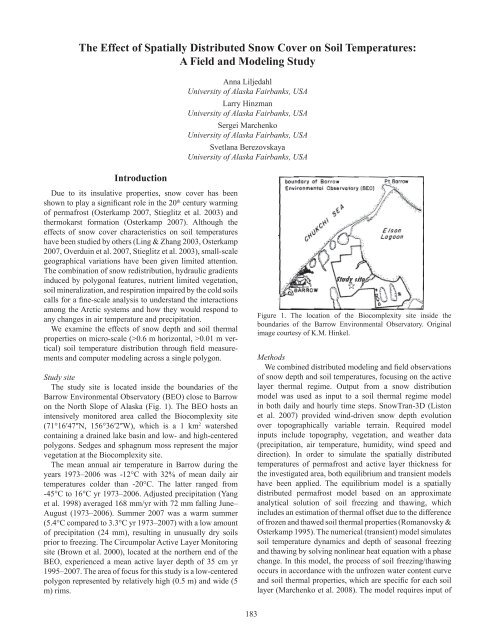Ninth International Conference on Permafrost ... - IARC Research
Ninth International Conference on Permafrost ... - IARC Research
Ninth International Conference on Permafrost ... - IARC Research
You also want an ePaper? Increase the reach of your titles
YUMPU automatically turns print PDFs into web optimized ePapers that Google loves.
The Effect of Spatially Distributed Snow Cover <strong>on</strong> Soil Temperatures:A Field and Modeling StudyIntroducti<strong>on</strong>Anna LiljedahlUniversity of Alaska Fairbanks, USALarry HinzmanUniversity of Alaska Fairbanks, USASergei MarchenkoUniversity of Alaska Fairbanks, USASvetlana BerezovskayaUniversity of Alaska Fairbanks, USADue to its insulative properties, snow cover has beenshown to play a significant role in the 20 th century warmingof permafrost (Osterkamp 2007, Stieglitz et al. 2003) andthermokarst formati<strong>on</strong> (Osterkamp 2007). Although theeffects of snow cover characteristics <strong>on</strong> soil temperatureshave been studied by others (Ling & Zhang 2003, Osterkamp2007, Overduin et al. 2007, Stieglitz et al. 2003), small-scalegeographical variati<strong>on</strong>s have been given limited attenti<strong>on</strong>.The combinati<strong>on</strong> of snow redistributi<strong>on</strong>, hydraulic gradientsinduced by polyg<strong>on</strong>al features, nutrient limited vegetati<strong>on</strong>,soil mineralizati<strong>on</strong>, and respirati<strong>on</strong> impaired by the cold soilscalls for a fine-scale analysis to understand the interacti<strong>on</strong>sam<strong>on</strong>g the Arctic systems and how they would resp<strong>on</strong>d toany changes in air temperature and precipitati<strong>on</strong>.We examine the effects of snow depth and soil thermalproperties <strong>on</strong> micro-scale (>0.6 m horiz<strong>on</strong>tal, >0.01 m vertical)soil temperature distributi<strong>on</strong> through field measurementsand computer modeling across a single polyg<strong>on</strong>.Study siteThe study site is located inside the boundaries of theBarrow Envir<strong>on</strong>mental Observatory (BEO) close to Barrow<strong>on</strong> the North Slope of Alaska (Fig. 1). The BEO hosts anintensively m<strong>on</strong>itored area called the Biocomplexity site(71°16′47ʺN, 156°36′2ʺW), which is a 1 km 2 watershedc<strong>on</strong>taining a drained lake basin and low- and high-centeredpolyg<strong>on</strong>s. Sedges and sphagnum moss represent the majorvegetati<strong>on</strong> at the Biocomplexity site.The mean annual air temperature in Barrow during theyears 1973–2006 was -12°C with 32% of mean daily airtemperatures colder than -20°C. The latter ranged from-45°C to 16°C yr 1973–2006. Adjusted precipitati<strong>on</strong> (Yanget al. 1998) averaged 168 mm/yr with 72 mm falling June–August (1973–2006). Summer 2007 was a warm summer(5.4°C compared to 3.3°C yr 1973–2007) with a low amountof precipitati<strong>on</strong> (24 mm), resulting in unusually dry soilsprior to freezing. The Circumpolar Active Layer M<strong>on</strong>itoringsite (Brown et al. 2000), located at the northern end of theBEO, experienced a mean active layer depth of 35 cm yr1995–2007. The area of focus for this study is a low-centeredpolyg<strong>on</strong> represented by relatively high (0.5 m) and wide (5m) rims.Figure 1. The locati<strong>on</strong> of the Biocomplexity site inside theboundaries of the Barrow Envir<strong>on</strong>mental Observatory. Originalimage courtesy of K.M. Hinkel.MethodsWe combined distributed modeling and field observati<strong>on</strong>sof snow depth and soil temperatures, focusing <strong>on</strong> the activelayer thermal regime. Output from a snow distributi<strong>on</strong>model was used as input to a soil thermal regime modelin both daily and hourly time steps. SnowTran-3D (List<strong>on</strong>et al. 2007) provided wind-driven snow depth evoluti<strong>on</strong>over topographically variable terrain. Required modelinputs include topography, vegetati<strong>on</strong>, and weather data(precipitati<strong>on</strong>, air temperature, humidity, wind speed anddirecti<strong>on</strong>). In order to simulate the spatially distributedtemperatures of permafrost and active layer thickness forthe investigated area, both equilibrium and transient modelshave been applied. The equilibrium model is a spatiallydistributed permafrost model based <strong>on</strong> an approximateanalytical soluti<strong>on</strong> of soil freezing and thawing, whichincludes an estimati<strong>on</strong> of thermal offset due to the differenceof frozen and thawed soil thermal properties (Romanovsky &Osterkamp 1995). The numerical (transient) model simulatessoil temperature dynamics and depth of seas<strong>on</strong>al freezingand thawing by solving n<strong>on</strong>linear heat equati<strong>on</strong> with a phasechange. In this model, the process of soil freezing/thawingoccurs in accordance with the unfrozen water c<strong>on</strong>tent curveand soil thermal properties, which are specific for each soillayer (Marchenko et al. 2008). The model requires input of183
















